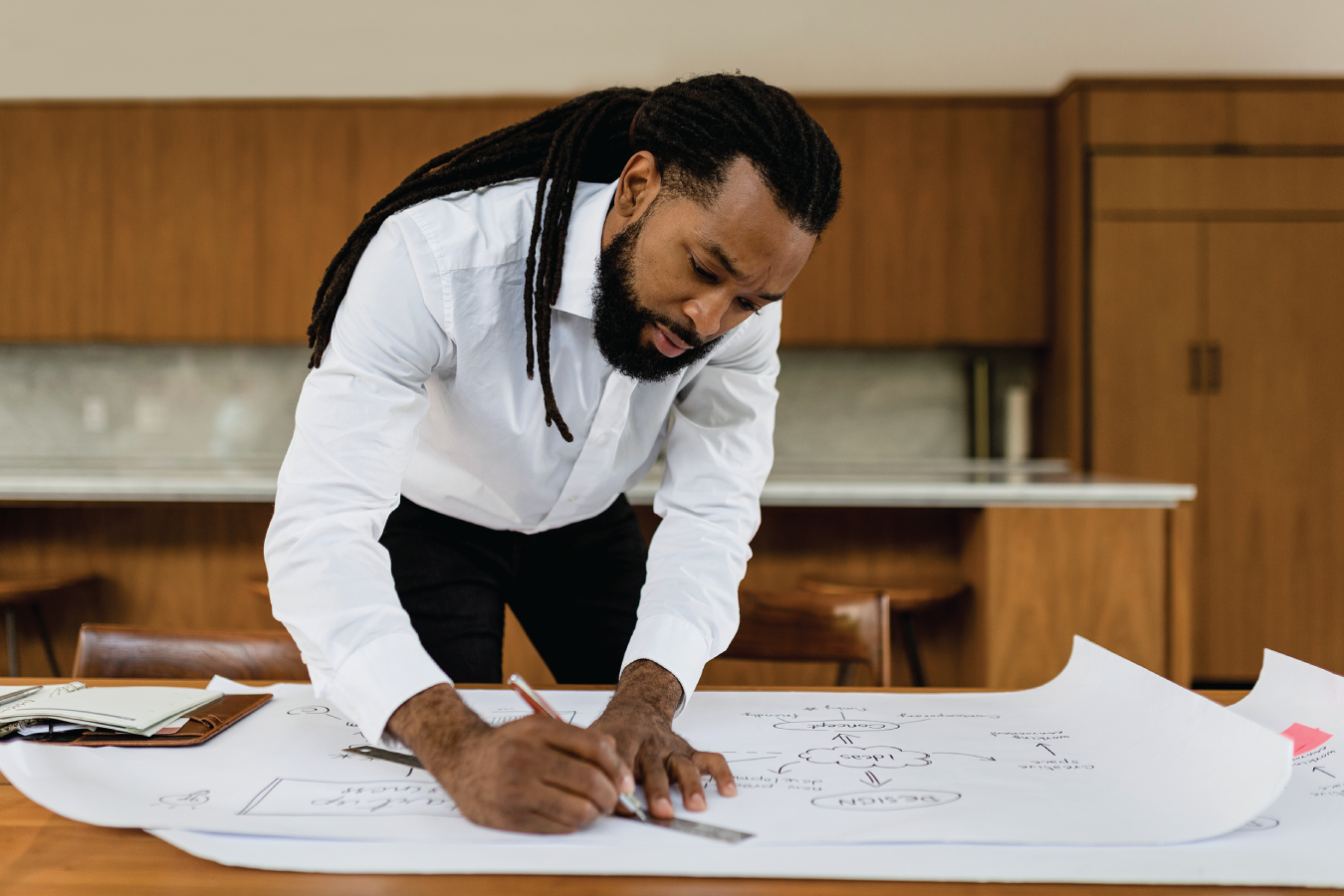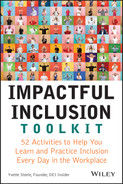ACTIVITY 10
Own Your Education
“Not everything that is faced can be changed. But nothing can be changed until it's faced.”
—James Baldwin
***
The presence of difference often sparks a range of emotions in the workplace. When it comes to the difference of a Black person's hair texture and style compared to that of a White person, I find that emotions range from curiosity to outrage. The natural hairstyles of Black Americans continue to be controversial and remain on the front line in the fight for racial equality as hairstyles are often deemed a distraction and inappropriate in the workplace by White people. By contrast, the natural hair styles and texture of White people never seem to so much as raise an eyebrow. For decades, professionalism has been dictated by how well one adapts to European physical features and mannerisms, and people who fall outside that construct must alter their appearance to be regarded as professional.
The intolerance for Black hairstyles serves as a barrier to employment, career advancement, and education, forcing Black people to conform to Eurocentric hairstyles. This requires the straightening of our coarse hair for the sake of economic independence. The Good Hair survey conducted by the Perception Institute revealed that “on average, white women show explicit bias toward black women's textured hair. They rate it as less beautiful, less sexy/attractive, and less professional than smooth hair. [Further], black women perceive a level of social stigma against textured hair, and this perception is substantiated by white women's devaluation of natural hairstyles.” Before Black people were enslaved in the United States, the hairstyles of many African tribes symbolized social and marital status, family background, and spirituality. Hair is considered to be an elevated part of one's body. Today, Black people are subjected to uninformed comments, sarcastic questions, and intrusive behaviors concerning their hair and must navigate the best way to respond without drawing further attention while demanding respect and setting personal boundaries.
Dina Neal, the first African American woman elected to the Nevada Assembly, shares her experience in a post with the Nevada Current. She explains that when she came to the state capitol in 2011, she wore her hair in braids and that her hairstyle was a practical choice. Carson City was snowy and cold, and she did not want to wear her hair wet while exposed in 25-degree weather. In 2013, a White staffer told her that her hairstyle was unprofessional and inappropriate. The comment stung, but Neal kept her braids. “I just dealt with it. I did not take the four hours to take out my braids,” she said in the interview. Eight years after that incident, Neal, now a state senator, saw an opportunity to change the status quo and introduced a bill to prohibit racial hair discrimination. During testimony at a Nevada legislative hearing, Wendy Greene, a professor at Drexel Kline School of Law and a leading authority on legal issues involving race and appearance, stated, “African descendant women and girls [are] in a precarious Catch-22: Either don your natural hair at the risk of lawfully being deprived of employment or an educational opportunity, or don straight hair at the risk of enduring consequential harm to your physical, psychological, economic and physical well-being.”
A post from JSTOR Daily details the story of Chastity Jones, an African American woman who wore her hair in locs. In 2010 Jones eagerly accepted a job offer from Catastrophe Management Solutions as a customer service representative. The offer, however, came with one stipulation—she had to cut off her locs. When she refused, the company rescinded the job offer. The company's hiring manager reportedly told Jones, “They tend to get messy.” The Equal Employment Opportunity Commission (EEOC) filed a suit on Jones's behalf in 2013 and lost. In 2016, the Eleventh Circuit Court of Appeals upheld the district court's ruling and dismissed the case.
Most of us in the workplace don't make hiring decisions or write organizational policy, but we can work to improve the company climate and experiences of Black colleagues who wear their hair in its natural state. When someone changes their hair from short to long overnight via wigs or extensions or wears locs, braids, twists, or other cultural hairstyles, it's natural to be curious. You may find yourself perplexed or fascinated by the shape and texture. Satisfying that curiosity does not mean that it is appropriate to touch your co-worker's hair, ask questions like “What do you call those” and “How long does that take?” Instead, educate yourself. Do the research on how hairstyles reflect culture and the requirement for Black people to assimilate into mainstream to achieve a basic level of acceptance. Asking to touch a Black person's hair infringes on personal space, conjures feelings of otherness, and makes an individual feel like they are on display or viewed as entertainment for their naturally straight-haired counterparts. Black hair has a long history of being politicized and stigmatized in the workplace. For Black people, it's not just about hair. It's about choice and being empowered to be who we are culturally in the workplace. Champions of inclusion recognize their cultural biases, acknowledge that perceptions of professionalism are relative, and choose to respect the whole individual without judgment.
See Figures 10.1 and 10.2.

Figure 10.1: Natural hair

Figure 10.2: Natural hair
Actions
Embrace That Natural Is Natural
Natural is defined as existing or caused by nature. The state of natural hair for one race should not demean the natural hair of another. Expand your view of beauty and professionalism. Binge watch a few movies and documentaries for a 360-degree perspective on the struggles, traumas, and triumphs. Check out:
- Back to Natural. View the trailer at
https://backtonaturaldoc.com. - My Nappy Roots: A Journey Through Black Hair-itage (2006) directed by Jay Bluemke / Regina Kimbell.
- Nappily Ever After (2018). View the trailer at
www.youtube.com/watch?v=e-pMVkg7wHg.
You can also add this list to your library: www.blackhairsyllabus.com/filmsdocs.
Reflect When Your Personal Space Was Violated
Everyone has experienced a violation of their personal space. Perhaps someone stood too close in an elevator, literally breathed down the back of your neck while in line, or stepped too close in conversation leaving no room to back up. Julius Fast, author of Body Language, explains that a person who violates personal space sends the signal, “You are a non-person, and therefore I can move in on you. You do not matter.” Personal space allows us to maintain our perceptions of safety and to protect ourselves. Consider a time when your personal space was violated and reflect on how it made you feel. Did you feel anger? Withdraw inwardly? Aggressively respond? Imagine that happening again and again by people you see every day. Examine what you are feeling in this moment to gain a new perspective.
Create Your Black Hair Experience
As you prepare for your next workday, think about whether your hair in its natural state would be of concern or offensive to co-workers, customers, or clients. Imagine if it were deemed unacceptable or unprofessional. Contemplate how their reactions may impact your day as well as career. Consider comments and reactions you've made or heard on the topic. Decide whether you will react differently in the future and in what way.
Action Accelerators
YouTube.com: No. You Cannot Touch My Hair! Mena Fombo, TEDxBristol:www.youtube.com/watch?v=OLQzz75yE5A&t=283sYouTube.com: The Psychology of Black Hair, Johanna Lukate, TEDxCambridgeUniversity:www.youtube.com/watch?v=-yJ17ysm5DY&t=490s- Book: Hair Story: Untangling the Roots of Black Hair in America by Ayana Byrd and Lori Tharps
Huffpost.com: “4 Questions About Hair That Black Girls Are Tired of Answering,” by Jolie A. Doggett:www.huffpost.com/entry/black-hair-annoying-questions_l_5c5b3d71e4b08710475a3dafBBC.com: “How does black hair reflect black history?” by Rumeana Jahangir:www.bbc.com/news/uk-england-merseyside-31438273
Sources Cited
- Perception.org. “The ‘Good Hair' Study Results, August 2016,
https://perception.org/goodhair/results - Lebo Matshego. “A History of African Women's Hairstyles Lifestyle,”
Africa.com, January 25, 2020,www.africa.com/history-african-womens-hairstyles - Marcia Mercer. “Banning Hair Discrimination Emerges as Racial Justice Issue,”
NevadaCurrent.com,www.nevadacurrent.com/2021/12/01/banning-hair-discrimination-emerges-as-racial-justice-issue - Chanté Griffin. “How Natural Black Hair at Work Became a Civil Rights Issue,”
Daily.JSTOR.org, July 3, 2019,https://daily.jstor.org/how-natural-black-hair-at-work-became-a-civil-rights-issue - Bakari Akil II Ph.D. “Personal Space: How Violating Unspoken Rules Can Lead to Chaos - at Least for You,”
PsychologyToday.com, April 11, 2010,www.psychologytoday.com/us/blog/communication-central/201004/personal-space-how-violating-unspoken-rules-can-lead-chaos-least
